
THOMSON REUTERS STREETEVENTS EDITED TRANSCRIPT ANF - Abercrombie & Fitch Co. at Jefferies Global Consumer Conference EVENT DATE/TIME: JUNE 18, 2013 / 2:30PM GMT THOMSON REUTERS STREETEVENTS | www.streetevents.com | Contact Us ©2013 Thomson Reuters. All rights reserved. Republication or redistribution of Thomson Reuters content, including by framing or similar means, is prohibited without the prior written consent of Thomson Reuters. 'Thomson Reuters' and the Thomson Reuters logo are registered trademarks of Thomson Reuters and its affiliated companies.
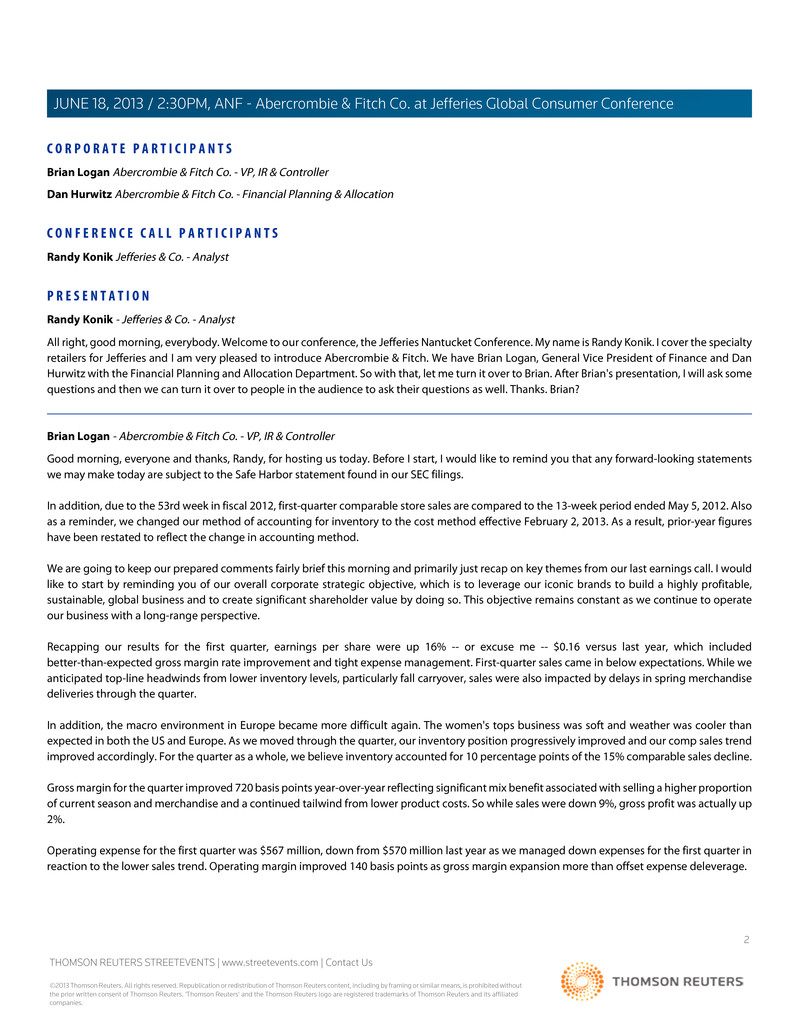
C O R P O R A T E P A R T I C I P A N T S Brian Logan Abercrombie & Fitch Co. - VP, IR & Controller Dan Hurwitz Abercrombie & Fitch Co. - Financial Planning & Allocation C O N F E R E N C E C A L L P A R T I C I P A N T S Randy Konik Jefferies & Co. - Analyst P R E S E N T A T I O N Randy Konik - Jefferies & Co. - Analyst All right, good morning, everybody. Welcome to our conference, the Jefferies Nantucket Conference. My name is Randy Konik. I cover the specialty retailers for Jefferies and I am very pleased to introduce Abercrombie & Fitch. We have Brian Logan, General Vice President of Finance and Dan Hurwitz with the Financial Planning and Allocation Department. So with that, let me turn it over to Brian. After Brian's presentation, I will ask some questions and then we can turn it over to people in the audience to ask their questions as well. Thanks. Brian? Brian Logan - Abercrombie & Fitch Co. - VP, IR & Controller Good morning, everyone and thanks, Randy, for hosting us today. Before I start, I would like to remind you that any forward-looking statements we may make today are subject to the Safe Harbor statement found in our SEC filings. In addition, due to the 53rd week in fiscal 2012, first-quarter comparable store sales are compared to the 13-week period ended May 5, 2012. Also as a reminder, we changed our method of accounting for inventory to the cost method effective February 2, 2013. As a result, prior-year figures have been restated to reflect the change in accounting method. We are going to keep our prepared comments fairly brief this morning and primarily just recap on key themes from our last earnings call. I would like to start by reminding you of our overall corporate strategic objective, which is to leverage our iconic brands to build a highly profitable, sustainable, global business and to create significant shareholder value by doing so. This objective remains constant as we continue to operate our business with a long-range perspective. Recapping our results for the first quarter, earnings per share were up 16% -- or excuse me -- $0.16 versus last year, which included better-than-expected gross margin rate improvement and tight expense management. First-quarter sales came in below expectations. While we anticipated top-line headwinds from lower inventory levels, particularly fall carryover, sales were also impacted by delays in spring merchandise deliveries through the quarter. In addition, the macro environment in Europe became more difficult again. The women's tops business was soft and weather was cooler than expected in both the US and Europe. As we moved through the quarter, our inventory position progressively improved and our comp sales trend improved accordingly. For the quarter as a whole, we believe inventory accounted for 10 percentage points of the 15% comparable sales decline. Gross margin for the quarter improved 720 basis points year-over-year reflecting significant mix benefit associated with selling a higher proportion of current season and merchandise and a continued tailwind from lower product costs. So while sales were down 9%, gross profit was actually up 2%. Operating expense for the first quarter was $567 million, down from $570 million last year as we managed down expenses for the first quarter in reaction to the lower sales trend. Operating margin improved 140 basis points as gross margin expansion more than offset expense deleverage. 2 THOMSON REUTERS STREETEVENTS | www.streetevents.com | Contact Us ©2013 Thomson Reuters. All rights reserved. Republication or redistribution of Thomson Reuters content, including by framing or similar means, is prohibited without the prior written consent of Thomson Reuters. 'Thomson Reuters' and the Thomson Reuters logo are registered trademarks of Thomson Reuters and its affiliated companies. JUNE 18, 2013 / 2:30PM, ANF - Abercrombie & Fitch Co. at Jefferies Global Consumer Conference
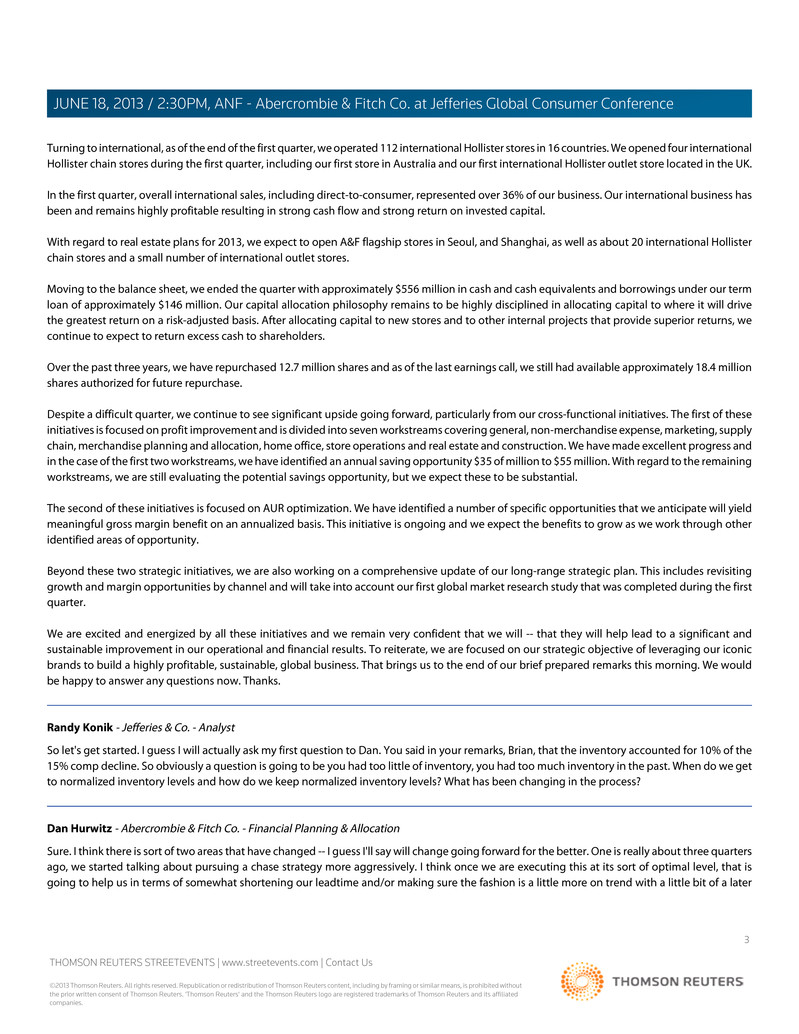
Turning to international, as of the end of the first quarter, we operated 112 international Hollister stores in 16 countries. We opened four international Hollister chain stores during the first quarter, including our first store in Australia and our first international Hollister outlet store located in the UK. In the first quarter, overall international sales, including direct-to-consumer, represented over 36% of our business. Our international business has been and remains highly profitable resulting in strong cash flow and strong return on invested capital. With regard to real estate plans for 2013, we expect to open A&F flagship stores in Seoul, and Shanghai, as well as about 20 international Hollister chain stores and a small number of international outlet stores. Moving to the balance sheet, we ended the quarter with approximately $556 million in cash and cash equivalents and borrowings under our term loan of approximately $146 million. Our capital allocation philosophy remains to be highly disciplined in allocating capital to where it will drive the greatest return on a risk-adjusted basis. After allocating capital to new stores and to other internal projects that provide superior returns, we continue to expect to return excess cash to shareholders. Over the past three years, we have repurchased 12.7 million shares and as of the last earnings call, we still had available approximately 18.4 million shares authorized for future repurchase. Despite a difficult quarter, we continue to see significant upside going forward, particularly from our cross-functional initiatives. The first of these initiatives is focused on profit improvement and is divided into seven workstreams covering general, non-merchandise expense, marketing, supply chain, merchandise planning and allocation, home office, store operations and real estate and construction. We have made excellent progress and in the case of the first two workstreams, we have identified an annual saving opportunity $35 of million to $55 million. With regard to the remaining workstreams, we are still evaluating the potential savings opportunity, but we expect these to be substantial. The second of these initiatives is focused on AUR optimization. We have identified a number of specific opportunities that we anticipate will yield meaningful gross margin benefit on an annualized basis. This initiative is ongoing and we expect the benefits to grow as we work through other identified areas of opportunity. Beyond these two strategic initiatives, we are also working on a comprehensive update of our long-range strategic plan. This includes revisiting growth and margin opportunities by channel and will take into account our first global market research study that was completed during the first quarter. We are excited and energized by all these initiatives and we remain very confident that we will -- that they will help lead to a significant and sustainable improvement in our operational and financial results. To reiterate, we are focused on our strategic objective of leveraging our iconic brands to build a highly profitable, sustainable, global business. That brings us to the end of our brief prepared remarks this morning. We would be happy to answer any questions now. Thanks. Randy Konik - Jefferies & Co. - Analyst So let's get started. I guess I will actually ask my first question to Dan. You said in your remarks, Brian, that the inventory accounted for 10% of the 15% comp decline. So obviously a question is going to be you had too little of inventory, you had too much inventory in the past. When do we get to normalized inventory levels and how do we keep normalized inventory levels? What has been changing in the process? Dan Hurwitz - Abercrombie & Fitch Co. - Financial Planning & Allocation Sure. I think there is sort of two areas that have changed -- I guess I'll say will change going forward for the better. One is really about three quarters ago, we started talking about pursuing a chase strategy more aggressively. I think once we are executing this at its sort of optimal level, that is going to help us in terms of somewhat shortening our leadtime and/or making sure the fashion is a little more on trend with a little bit of a later 3 THOMSON REUTERS STREETEVENTS | www.streetevents.com | Contact Us ©2013 Thomson Reuters. All rights reserved. Republication or redistribution of Thomson Reuters content, including by framing or similar means, is prohibited without the prior written consent of Thomson Reuters. 'Thomson Reuters' and the Thomson Reuters logo are registered trademarks of Thomson Reuters and its affiliated companies. JUNE 18, 2013 / 2:30PM, ANF - Abercrombie & Fitch Co. at Jefferies Global Consumer Conference
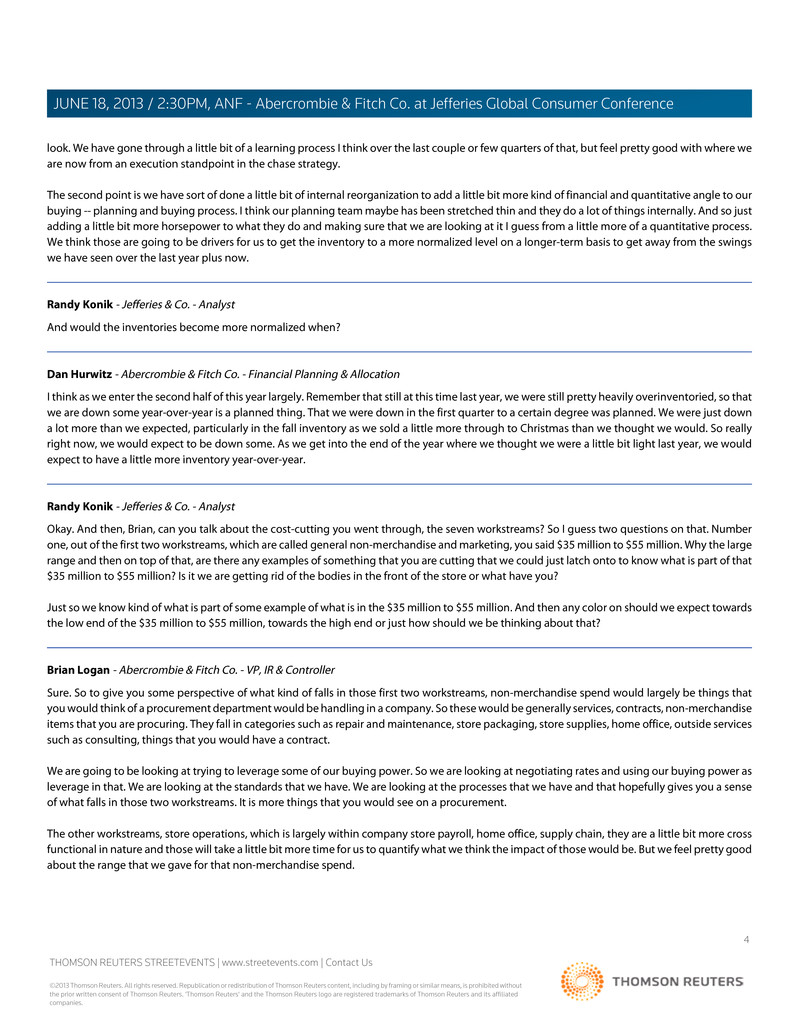
look. We have gone through a little bit of a learning process I think over the last couple or few quarters of that, but feel pretty good with where we are now from an execution standpoint in the chase strategy. The second point is we have sort of done a little bit of internal reorganization to add a little bit more kind of financial and quantitative angle to our buying -- planning and buying process. I think our planning team maybe has been stretched thin and they do a lot of things internally. And so just adding a little bit more horsepower to what they do and making sure that we are looking at it I guess from a little more of a quantitative process. We think those are going to be drivers for us to get the inventory to a more normalized level on a longer-term basis to get away from the swings we have seen over the last year plus now. Randy Konik - Jefferies & Co. - Analyst And would the inventories become more normalized when? Dan Hurwitz - Abercrombie & Fitch Co. - Financial Planning & Allocation I think as we enter the second half of this year largely. Remember that still at this time last year, we were still pretty heavily overinventoried, so that we are down some year-over-year is a planned thing. That we were down in the first quarter to a certain degree was planned. We were just down a lot more than we expected, particularly in the fall inventory as we sold a little more through to Christmas than we thought we would. So really right now, we would expect to be down some. As we get into the end of the year where we thought we were a little bit light last year, we would expect to have a little more inventory year-over-year. Randy Konik - Jefferies & Co. - Analyst Okay. And then, Brian, can you talk about the cost-cutting you went through, the seven workstreams? So I guess two questions on that. Number one, out of the first two workstreams, which are called general non-merchandise and marketing, you said $35 million to $55 million. Why the large range and then on top of that, are there any examples of something that you are cutting that we could just latch onto to know what is part of that $35 million to $55 million? Is it we are getting rid of the bodies in the front of the store or what have you? Just so we know kind of what is part of some example of what is in the $35 million to $55 million. And then any color on should we expect towards the low end of the $35 million to $55 million, towards the high end or just how should we be thinking about that? Brian Logan - Abercrombie & Fitch Co. - VP, IR & Controller Sure. So to give you some perspective of what kind of falls in those first two workstreams, non-merchandise spend would largely be things that you would think of a procurement department would be handling in a company. So these would be generally services, contracts, non-merchandise items that you are procuring. They fall in categories such as repair and maintenance, store packaging, store supplies, home office, outside services such as consulting, things that you would have a contract. We are going to be looking at trying to leverage some of our buying power. So we are looking at negotiating rates and using our buying power as leverage in that. We are looking at the standards that we have. We are looking at the processes that we have and that hopefully gives you a sense of what falls in those two workstreams. It is more things that you would see on a procurement. The other workstreams, store operations, which is largely within company store payroll, home office, supply chain, they are a little bit more cross functional in nature and those will take a little bit more time for us to quantify what we think the impact of those would be. But we feel pretty good about the range that we gave for that non-merchandise spend. 4 THOMSON REUTERS STREETEVENTS | www.streetevents.com | Contact Us ©2013 Thomson Reuters. All rights reserved. Republication or redistribution of Thomson Reuters content, including by framing or similar means, is prohibited without the prior written consent of Thomson Reuters. 'Thomson Reuters' and the Thomson Reuters logo are registered trademarks of Thomson Reuters and its affiliated companies. JUNE 18, 2013 / 2:30PM, ANF - Abercrombie & Fitch Co. at Jefferies Global Consumer Conference
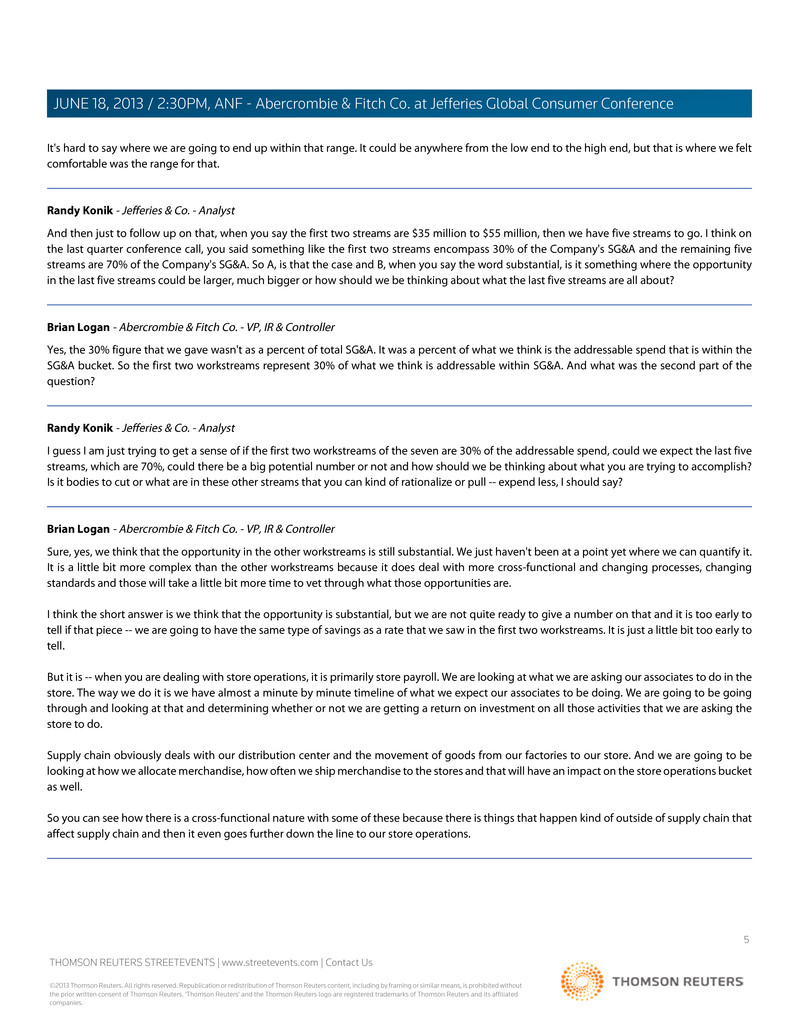
It's hard to say where we are going to end up within that range. It could be anywhere from the low end to the high end, but that is where we felt comfortable was the range for that. Randy Konik - Jefferies & Co. - Analyst And then just to follow up on that, when you say the first two streams are $35 million to $55 million, then we have five streams to go. I think on the last quarter conference call, you said something like the first two streams encompass 30% of the Company's SG&A and the remaining five streams are 70% of the Company's SG&A. So A, is that the case and B, when you say the word substantial, is it something where the opportunity in the last five streams could be larger, much bigger or how should we be thinking about what the last five streams are all about? Brian Logan - Abercrombie & Fitch Co. - VP, IR & Controller Yes, the 30% figure that we gave wasn't as a percent of total SG&A. It was a percent of what we think is the addressable spend that is within the SG&A bucket. So the first two workstreams represent 30% of what we think is addressable within SG&A. And what was the second part of the question? Randy Konik - Jefferies & Co. - Analyst I guess I am just trying to get a sense of if the first two workstreams of the seven are 30% of the addressable spend, could we expect the last five streams, which are 70%, could there be a big potential number or not and how should we be thinking about what you are trying to accomplish? Is it bodies to cut or what are in these other streams that you can kind of rationalize or pull -- expend less, I should say? Brian Logan - Abercrombie & Fitch Co. - VP, IR & Controller Sure, yes, we think that the opportunity in the other workstreams is still substantial. We just haven't been at a point yet where we can quantify it. It is a little bit more complex than the other workstreams because it does deal with more cross-functional and changing processes, changing standards and those will take a little bit more time to vet through what those opportunities are. I think the short answer is we think that the opportunity is substantial, but we are not quite ready to give a number on that and it is too early to tell if that piece -- we are going to have the same type of savings as a rate that we saw in the first two workstreams. It is just a little bit too early to tell. But it is -- when you are dealing with store operations, it is primarily store payroll. We are looking at what we are asking our associates to do in the store. The way we do it is we have almost a minute by minute timeline of what we expect our associates to be doing. We are going to be going through and looking at that and determining whether or not we are getting a return on investment on all those activities that we are asking the store to do. Supply chain obviously deals with our distribution center and the movement of goods from our factories to our store. And we are going to be looking at how we allocate merchandise, how often we ship merchandise to the stores and that will have an impact on the store operations bucket as well. So you can see how there is a cross-functional nature with some of these because there is things that happen kind of outside of supply chain that affect supply chain and then it even goes further down the line to our store operations. 5 THOMSON REUTERS STREETEVENTS | www.streetevents.com | Contact Us ©2013 Thomson Reuters. All rights reserved. Republication or redistribution of Thomson Reuters content, including by framing or similar means, is prohibited without the prior written consent of Thomson Reuters. 'Thomson Reuters' and the Thomson Reuters logo are registered trademarks of Thomson Reuters and its affiliated companies. JUNE 18, 2013 / 2:30PM, ANF - Abercrombie & Fitch Co. at Jefferies Global Consumer Conference
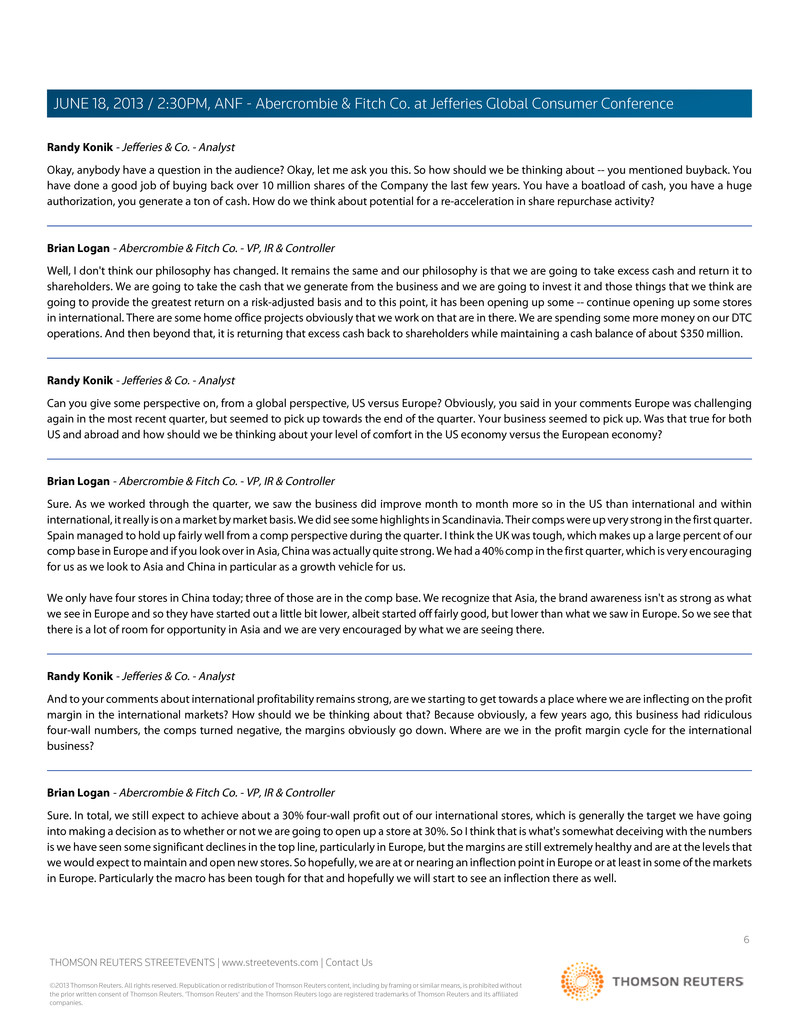
Randy Konik - Jefferies & Co. - Analyst Okay, anybody have a question in the audience? Okay, let me ask you this. So how should we be thinking about -- you mentioned buyback. You have done a good job of buying back over 10 million shares of the Company the last few years. You have a boatload of cash, you have a huge authorization, you generate a ton of cash. How do we think about potential for a re-acceleration in share repurchase activity? Brian Logan - Abercrombie & Fitch Co. - VP, IR & Controller Well, I don't think our philosophy has changed. It remains the same and our philosophy is that we are going to take excess cash and return it to shareholders. We are going to take the cash that we generate from the business and we are going to invest it and those things that we think are going to provide the greatest return on a risk-adjusted basis and to this point, it has been opening up some -- continue opening up some stores in international. There are some home office projects obviously that we work on that are in there. We are spending some more money on our DTC operations. And then beyond that, it is returning that excess cash back to shareholders while maintaining a cash balance of about $350 million. Randy Konik - Jefferies & Co. - Analyst Can you give some perspective on, from a global perspective, US versus Europe? Obviously, you said in your comments Europe was challenging again in the most recent quarter, but seemed to pick up towards the end of the quarter. Your business seemed to pick up. Was that true for both US and abroad and how should we be thinking about your level of comfort in the US economy versus the European economy? Brian Logan - Abercrombie & Fitch Co. - VP, IR & Controller Sure. As we worked through the quarter, we saw the business did improve month to month more so in the US than international and within international, it really is on a market by market basis. We did see some highlights in Scandinavia. Their comps were up very strong in the first quarter. Spain managed to hold up fairly well from a comp perspective during the quarter. I think the UK was tough, which makes up a large percent of our comp base in Europe and if you look over in Asia, China was actually quite strong. We had a 40% comp in the first quarter, which is very encouraging for us as we look to Asia and China in particular as a growth vehicle for us. We only have four stores in China today; three of those are in the comp base. We recognize that Asia, the brand awareness isn't as strong as what we see in Europe and so they have started out a little bit lower, albeit started off fairly good, but lower than what we saw in Europe. So we see that there is a lot of room for opportunity in Asia and we are very encouraged by what we are seeing there. Randy Konik - Jefferies & Co. - Analyst And to your comments about international profitability remains strong, are we starting to get towards a place where we are inflecting on the profit margin in the international markets? How should we be thinking about that? Because obviously, a few years ago, this business had ridiculous four-wall numbers, the comps turned negative, the margins obviously go down. Where are we in the profit margin cycle for the international business? Brian Logan - Abercrombie & Fitch Co. - VP, IR & Controller Sure. In total, we still expect to achieve about a 30% four-wall profit out of our international stores, which is generally the target we have going into making a decision as to whether or not we are going to open up a store at 30%. So I think that is what's somewhat deceiving with the numbers is we have seen some significant declines in the top line, particularly in Europe, but the margins are still extremely healthy and are at the levels that we would expect to maintain and open new stores. So hopefully, we are at or nearing an inflection point in Europe or at least in some of the markets in Europe. Particularly the macro has been tough for that and hopefully we will start to see an inflection there as well. 6 THOMSON REUTERS STREETEVENTS | www.streetevents.com | Contact Us ©2013 Thomson Reuters. All rights reserved. Republication or redistribution of Thomson Reuters content, including by framing or similar means, is prohibited without the prior written consent of Thomson Reuters. 'Thomson Reuters' and the Thomson Reuters logo are registered trademarks of Thomson Reuters and its affiliated companies. JUNE 18, 2013 / 2:30PM, ANF - Abercrombie & Fitch Co. at Jefferies Global Consumer Conference
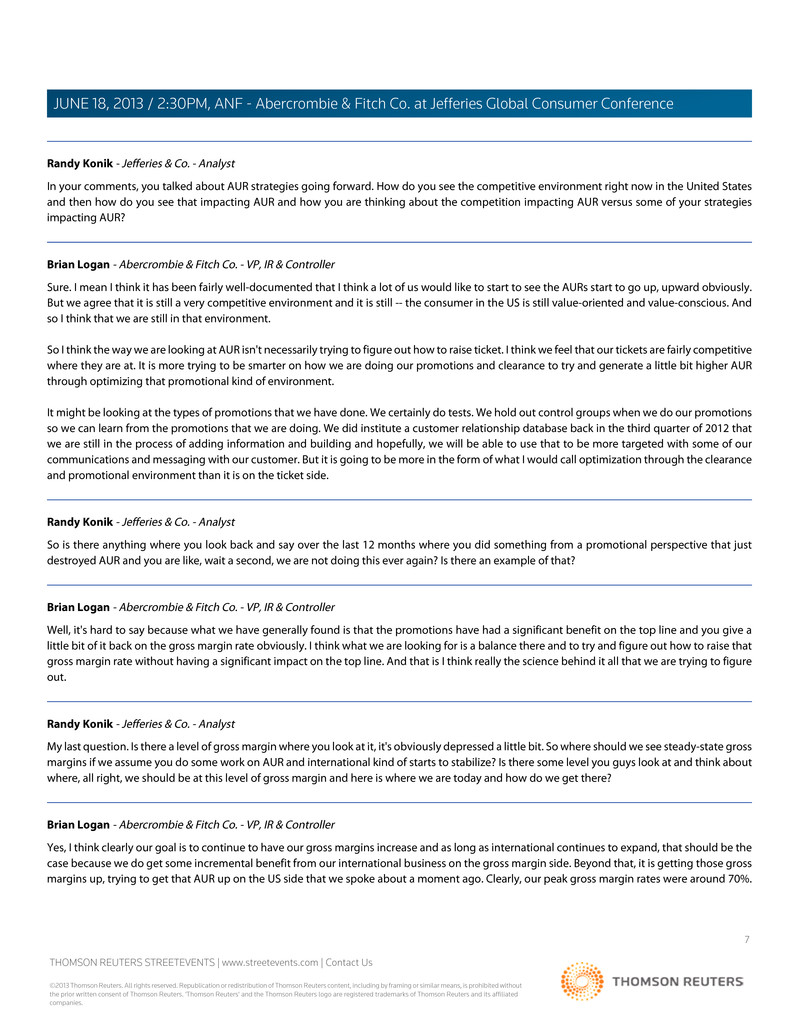
Randy Konik - Jefferies & Co. - Analyst In your comments, you talked about AUR strategies going forward. How do you see the competitive environment right now in the United States and then how do you see that impacting AUR and how you are thinking about the competition impacting AUR versus some of your strategies impacting AUR? Brian Logan - Abercrombie & Fitch Co. - VP, IR & Controller Sure. I mean I think it has been fairly well-documented that I think a lot of us would like to start to see the AURs start to go up, upward obviously. But we agree that it is still a very competitive environment and it is still -- the consumer in the US is still value-oriented and value-conscious. And so I think that we are still in that environment. So I think the way we are looking at AUR isn't necessarily trying to figure out how to raise ticket. I think we feel that our tickets are fairly competitive where they are at. It is more trying to be smarter on how we are doing our promotions and clearance to try and generate a little bit higher AUR through optimizing that promotional kind of environment. It might be looking at the types of promotions that we have done. We certainly do tests. We hold out control groups when we do our promotions so we can learn from the promotions that we are doing. We did institute a customer relationship database back in the third quarter of 2012 that we are still in the process of adding information and building and hopefully, we will be able to use that to be more targeted with some of our communications and messaging with our customer. But it is going to be more in the form of what I would call optimization through the clearance and promotional environment than it is on the ticket side. Randy Konik - Jefferies & Co. - Analyst So is there anything where you look back and say over the last 12 months where you did something from a promotional perspective that just destroyed AUR and you are like, wait a second, we are not doing this ever again? Is there an example of that? Brian Logan - Abercrombie & Fitch Co. - VP, IR & Controller Well, it's hard to say because what we have generally found is that the promotions have had a significant benefit on the top line and you give a little bit of it back on the gross margin rate obviously. I think what we are looking for is a balance there and to try and figure out how to raise that gross margin rate without having a significant impact on the top line. And that is I think really the science behind it all that we are trying to figure out. Randy Konik - Jefferies & Co. - Analyst My last question. Is there a level of gross margin where you look at it, it's obviously depressed a little bit. So where should we see steady-state gross margins if we assume you do some work on AUR and international kind of starts to stabilize? Is there some level you guys look at and think about where, all right, we should be at this level of gross margin and here is where we are today and how do we get there? Brian Logan - Abercrombie & Fitch Co. - VP, IR & Controller Yes, I think clearly our goal is to continue to have our gross margins increase and as long as international continues to expand, that should be the case because we do get some incremental benefit from our international business on the gross margin side. Beyond that, it is getting those gross margins up, trying to get that AUR up on the US side that we spoke about a moment ago. Clearly, our peak gross margin rates were around 70%. 7 THOMSON REUTERS STREETEVENTS | www.streetevents.com | Contact Us ©2013 Thomson Reuters. All rights reserved. Republication or redistribution of Thomson Reuters content, including by framing or similar means, is prohibited without the prior written consent of Thomson Reuters. 'Thomson Reuters' and the Thomson Reuters logo are registered trademarks of Thomson Reuters and its affiliated companies. JUNE 18, 2013 / 2:30PM, ANF - Abercrombie & Fitch Co. at Jefferies Global Consumer Conference
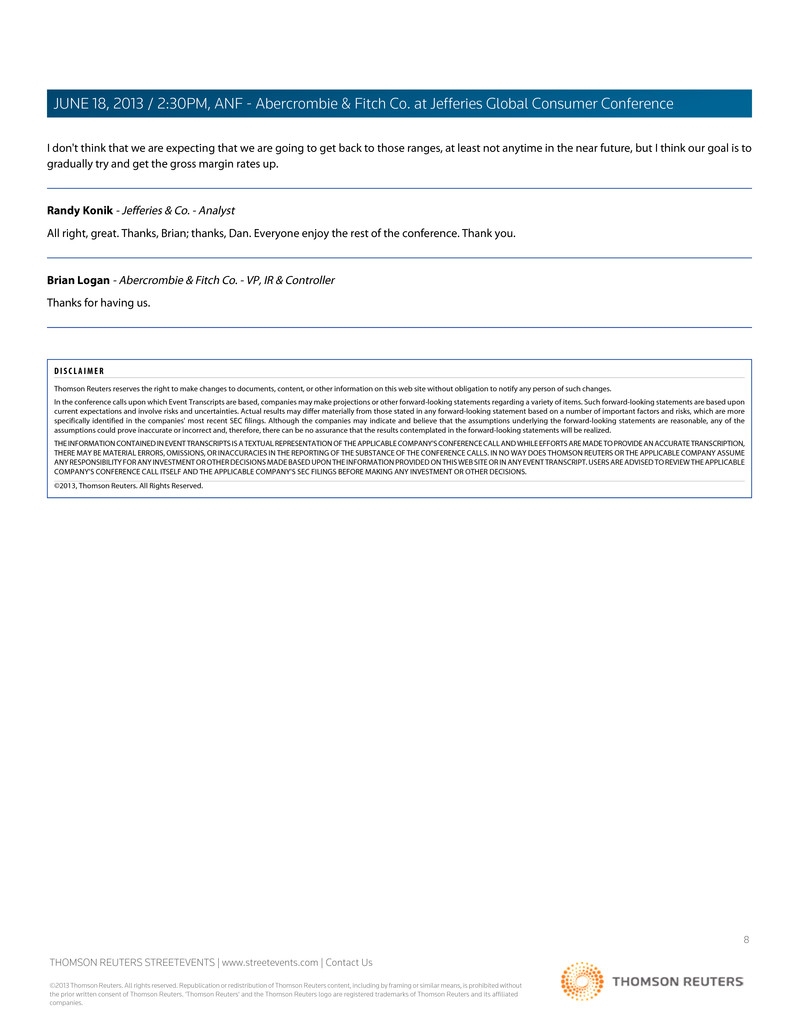
I don't think that we are expecting that we are going to get back to those ranges, at least not anytime in the near future, but I think our goal is to gradually try and get the gross margin rates up. Randy Konik - Jefferies & Co. - Analyst All right, great. Thanks, Brian; thanks, Dan. Everyone enjoy the rest of the conference. Thank you. Brian Logan - Abercrombie & Fitch Co. - VP, IR & Controller Thanks for having us. D I S C L A I M E R Thomson Reuters reserves the right to make changes to documents, content, or other information on this web site without obligation to notify any person of such changes. In the conference calls upon which Event Transcripts are based, companies may make projections or other forward-looking statements regarding a variety of items. Such forward-looking statements are based upon current expectations and involve risks and uncertainties. Actual results may differ materially from those stated in any forward-looking statement based on a number of important factors and risks, which are more specifically identified in the companies' most recent SEC filings. Although the companies may indicate and believe that the assumptions underlying the forward-looking statements are reasonable, any of the assumptions could prove inaccurate or incorrect and, therefore, there can be no assurance that the results contemplated in the forward-looking statements will be realized. THE INFORMATION CONTAINED IN EVENT TRANSCRIPTS IS A TEXTUAL REPRESENTATION OF THE APPLICABLE COMPANY'S CONFERENCE CALL AND WHILE EFFORTS ARE MADE TO PROVIDE AN ACCURATE TRANSCRIPTION, THERE MAY BE MATERIAL ERRORS, OMISSIONS, OR INACCURACIES IN THE REPORTING OF THE SUBSTANCE OF THE CONFERENCE CALLS. IN NO WAY DOES THOMSON REUTERS OR THE APPLICABLE COMPANY ASSUME ANY RESPONSIBILITY FOR ANY INVESTMENT OR OTHER DECISIONS MADE BASED UPON THE INFORMATION PROVIDED ON THIS WEB SITE OR IN ANY EVENT TRANSCRIPT. USERS ARE ADVISED TO REVIEW THE APPLICABLE COMPANY'S CONFERENCE CALL ITSELF AND THE APPLICABLE COMPANY'S SEC FILINGS BEFORE MAKING ANY INVESTMENT OR OTHER DECISIONS. ©2013, Thomson Reuters. All Rights Reserved. 5110797-2013-06-20T19:50:32.080 8 THOMSON REUTERS STREETEVENTS | www.streetevents.com | Contact Us ©2013 Thomson Reuters. All rights reserved. Republication or redistribution of Thomson Reuters content, including by framing or similar means, is prohibited without the prior written consent of Thomson Reuters. 'Thomson Reuters' and the Thomson Reuters logo are registered trademarks of Thomson Reuters and its affiliated companies. JUNE 18, 2013 / 2:30PM, ANF - Abercrombie & Fitch Co. at Jefferies Global Consumer Conference







